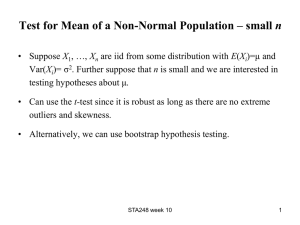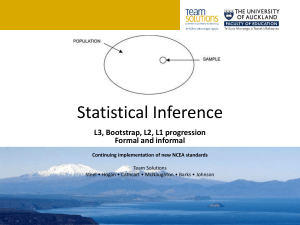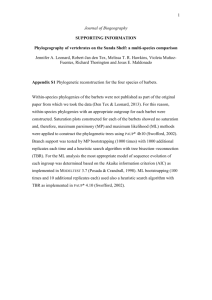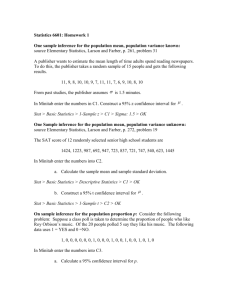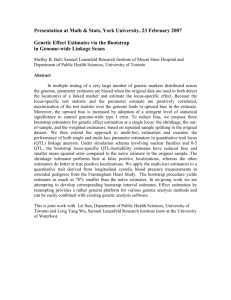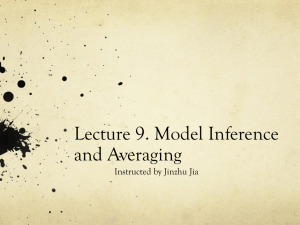Document 10442925
advertisement
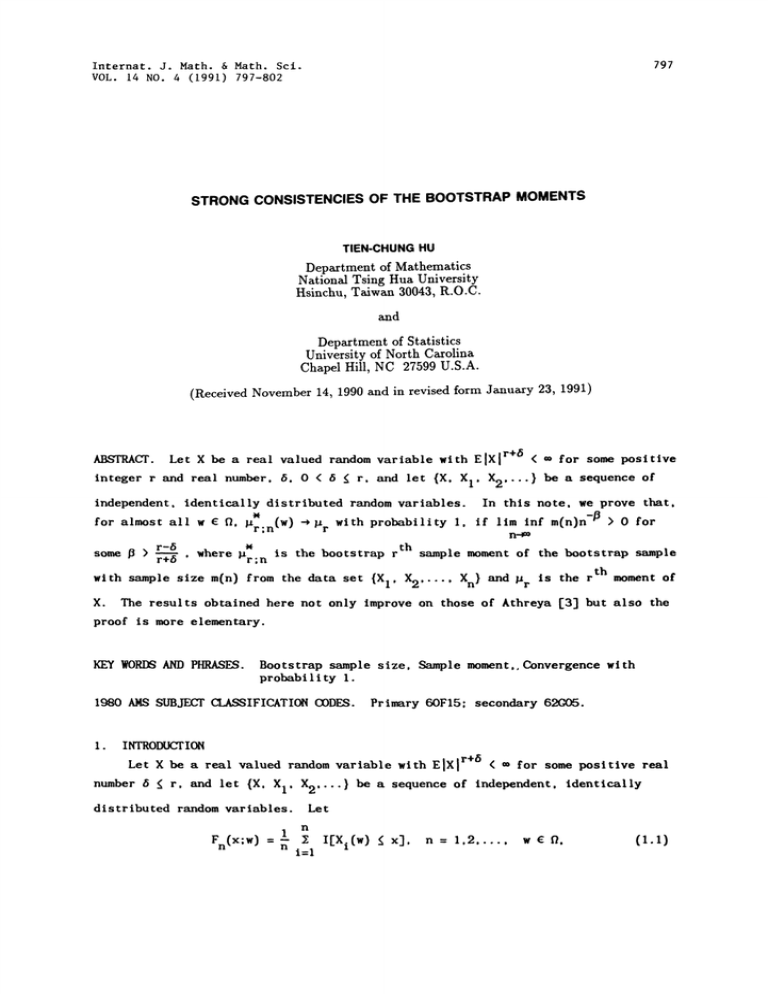
797
Internat. J. Math. & Math. Sci.
VOL. 14 NO. 4 (1991) 797-802
STRONG CONSISTENCIES OF THE BOOTSTRAP MOMENTS
TIEN-CHUNG HU
Department of Mathematics
National Tsing Hua University
Hsinchu, Taiwan 30043, R.O.C.
and
Department of Statistics
University of North Carolina
Chapel Hill, N C 27599 U.S.A.
(Received November 14, 1990 and in revised form January 23, 1991)
r+ < for some positive
Let X be a real valued random variable with
be a sequence of
r, and let {X, X
integer r and real number. 6. 0 < 5
I. X2
independent, identically distributed random variables. In this note, we prove that,
for almost all w e
with probability 1. if lim inf m
> 0 for
r.n(W)
EIXI
CF.
,
>
r-5
(n)n-
r
r;n
th
sample moment of the bootstrap sample
th
with sample size m{n) from the data set {X I, X
Xn} and is the r moment of
2
X. The results obtained here not only improve on those of Athreya [3] but also the
some
where
is the bootstrap r
Pr
proof is more elementary.
KEY WORDS AND PHRASES.
Bootstrap sample
probabi
1980 AMS
size, Sample moment.,
Convergence with
ty 1.
SUBJF CLARIFICATION CODES.
Primary 60F15; secondary 62C05.
INTRODUION
r+5
Let X be a real valued random variable with
< for some positive real
r, and let {X, X
number 6
be
a sequence of independent, identically
I. X2
I.
EIXI
distributed random variables.
Fn(X’W)
n
Let
n
2
i=1
l[Xi(w
x], n
1,2,...,
w e
,
{I.I)
T.C. HU
798
{Xl{W ). X2{w ).
{Xnl{W ). Xn2(W)
be the empirical distribution functions associated with the sequence
).
X3(w
XrunCn){W)}
For every positive integer n and w E f}, let
be independent, identically distributed random variables with distribution
Fn(X’W}
function
.
We call
(I.I}.
defined as in
Xnm{n}{W}}
{Xnl{W }. Xn2{W }.
the
bootstrap sample set with bootstrap sample size m(n}; it is required that m(n}
th
sample moment of {Xl{W ).
the r
and
Denote by
n
n.r{W}
Pn.r{W}
X2{w
Xn{W)}
Xnm(n{W)} respectively
and the bootstrap r
gn(W)
and
(w)
th
gn;l(W)
sample moment of
r
and denote by
instead of
and
the r
th
gn.l(W)"
[1],
{Xnl{X ). Xn2(w
moment of
further
sample mean and bootstrap sample mean respectively.
theory of Efron
as
X.
gn{W)
{When r=l, we use
and
gn(W)
are called
A problem, from the bootstrap
is to find conditions such that, for almost all w, the bootstrap
sample mean converges to the population mean {when it exists).
That is, for almost
all w.
ln.r{W)
with probability 1.
-*I r
as
{1.2}
n -m
By using the abstract "Vasserstein’s metric" among distributions
< w, then
[2] showed that if
EIX
and a Rallow type inequality, Bickel and Freedman
for almost all w E
for some 0
,
{2) holds
m{n)n-/3
1, and lim inf
almost all w e
0
Athreya [3] found that if
<
0 for some /3 > 0 such that
> I, then for
EIXI
in probability.
>
,
{1.2) holds with probability 1. To show this he used the difficult
and complex inequality of Kurtz [d]. Bickel and Freedman and Athreya used deep
mathematics and hard inequalities to prove the consistency of the bootstrap sample
mean to the population mean.
Their proofs are not easily comprehended.
This note,
provides an elementary way to obtain the strong consistency, relying on the }4arkov
inequality.
oreover,
the consistency property holds under weaker conditions than
those presented in Athreya
2.
[3].
RESULTS AND PROOFS
THEOREb[ 2.1. Let {X. X
1. X2
dtstrtbuted random vartables vtth
5
r.
Then, for almost all w
be a sequence o[ tndependent,
E[X[
r+i
< for some integer r
(1.2) holds atth probabtlttN
9,
tdenttcallN
and real number
1,
tf
lira inf
n-o
m(n)n-/3 >
0 for some real number /
>
0 such that /3
> r-’"
First. a lemma is needed in proving the theorem. The lemma is known in the
For the sake of completeness, a proof for the lemma is given.
literature.
Let {X, X 1. X
be a sequence of independent, identically
2
distributed random variables. Then. for any 0 < p ( 1, EIX[ p (
implies that
2.2.
799
STRONG CONSISTENCIES OF THE BOOTSTRAP MOMENTS
<
Y.
ty I.
wi th probabi
n=l
PROOF.
Let Y
n
Ixn
n
Ixn
Thus
lip
. e(IXnl
Ixn
:
P( ]x p
>
> n l/p)
<
n}
n=l
since
EIxI p < -.
Defining
: E(IYn =)
n=l
Aj
n=l J=l
{{j-l) 1/p
"fAJ
a/p
n
(j)I/p},
< Ixl
IX ladP
j=l
.
ElY
Choosing a
I,
.J’^j Ix = dP
Ixl p c EIxl p <
and 2, we have that
<"
and
2 Var Y
n
n=l
q
c
J=l
where the constant C depends only on a and p.
n--1
:z
n=J na/p
j=l
Ix
we have. for a
.
<
Thus, by the "three series Theorem" of Kolmogorov the lemma is established.
We are now in a position to prove the main result, which provides the strong
consistency of the bootstrap sample moments.
PROOF OF THEORF 2.1. It suffices to prove the result for the case r=l. The
other cases can be proved in a similar way with minor changes. Recall that, for each
n and w E f}. {Xnl{W), Xn2{w
are the independent, identically
XnmCn){W))
distributed random variables with distribution function defined in
{1.1). By the
strong law of large numbers, we have for almost all w
/n{W)
Thus.
it suffices to show
-H as n
with probability I.
(2.1)
that. for almost all w
I:{w} .n{W}l --... o
all w
--.
as
From the Borel-Cantelll lemma, we only need to prove for almost
I and for every e > O,
T.C. HU
800
r.
Xni (w) llnCW >
I.-2- i=l
n=1
Ix c-). x2c.)
e
-
For the case of presentation, we suppress all the symbol w in
(
Let q be an integer such that 1
q
and the symbol n in re(n).
Xarkov inequal ty, we have
m
m
P[] il Xni-ln] )e]XI’X2 Xn}
x.c.) <
(R).
Xi(w ). Xni(W)
and
ttn(W
1-8 and from the
1-
{_)2q E[{i=l{Xni_ln))2q[xi.x2
Xn]
{2.3}
Now we write
n
m
.
m
m
Y.
E
12q=1
ii=1 i2=1
2q
Y"
t=l
ql+...+qt=2q
qil,i=l
(Xni 2q-*n) IX
(Xni l-ln)
{2q)!
Y
.
r
qt"((7)
ql
E(Xnl-n
C2q!
qi22. i=l
xn]
Xl.X2
since
Further the last equality in
E{Xnl-n
b for a
n
n
n
q
m
t=l
t
(2.4)
is
Justified
.
qi=l. In
-.n
c)t i-1-
CXi-Xn)
since
identically
Xnl
Xn2,..
as n
the sequel, we use the shorthand
Thus, from
[(Xnl-,n)ql
x
t:l
O(bn)
Xnmare
Xnl, Xn2
0 implies that there is no contribution for those
terms which contain at least one of
notation a
XnJ
Xn]
E
(2.4) holds
where the third equality in
are independent and
qt
{Xnt-/n) IX ,x2
t
...E[{Xnt-.n}qt
distributed.
q
Xnl
,..., {7) [{Xnl_btn}ql Ix.x.
"+qt =2q
ql +"
2
t
q
t=l
,X
(x-.n)
i--1 (Xi-n)
(2.4)
we have
Xnm
801
STRONG CONSISTENCIES OF THE BOOTSTRAP MOMENTS
n
n
q
Ix+. lqt+ l..lqt)]
2q
2
qt
(Ixi t+
i=l
since
2q and where the first inequality in (2.5) is obtained
2. ql+q2+...+qt
qj
for fact that
[a+bl
s
Inl qt)
2S(lalS+]b[ s)
for a. b and s real numbers. Since I is finite
it follows from (2.1) that. for almost all w. there exists a constant C such that
Further note that 5 <
and qj
2 for J
q which imply
/a < C for every n.
1.2
n
>
I.
Thus. for almost all w
-
qj
qj-l+5
lnl qJ < -. +
i=l
Now applying our lemma
qj
to
t.2
qj-t++ <
qt
and choosing p
(2.6)
q.
1. we have. for almost all
weft.
.1.qj-l+5
i=1
Without loss of generality we put
I-_._5
1+5
then from
IX i iqj
tT
< m. J
n/ where
mCn)
1.2
{2.7)
q.
/ is some real number such that
{2 5} C2.6) and C2 7) we have
2qJg+{ l-/) t
q
Denote the exponent of
@(t)
(}
in
2
+ (1-/)t
(2.8)
as
@(t) for
t
qj
J=l
qj-l+5
2
2- t(/-I + T-
t
t
qJ
J=l qj-l+5
1.2
q.
Note that
T.C. HU
802
1-5
(2.0)
1-6
-)
q(
1,2
for
q,
where (2.9) holds since
q-l/6
<
2
"
for
J
1,2
(2.2) follows From (2.3). (2.8) and (2.10).
appropriate choice of q.
By the
t.
This completes
the proof.
Theorem
of Athreya. stated in Corollary 2.3. is an immediate consequence of
our Theorem 2. I.
03ROSY 2.3.
EIXI
<
and re(n)
If E X2
<
and
If
pn
for some p ) 1, then (2.2) holds, for
r=l.
COROY 2.4.
PROOF.
.
p >
O.
case
By letting 6
m(n)
for some
p >
O, then (2.2} holds for
l-a for some
p
Let m(n) growth with an algebraic rate: that is, m(n)
for some
First note that 1+6 in our notation plays the role of 8 in Athreya’s. In
I-6
< 8 < 2 we have >
Hence, in this case, our condition Is strictly
n
1-> -.
weaker than the one is posed by Athreya.
is even much weaker than
if O
’
n
p >
In
case 8
2. we only require
) 0 which
the requirement in the Theorem 2 of Athreya.
1, then both of our theorem and Athreya’s theorem require
>
However,
I.
Recently. the author learned that Professor Csorgo also improved the result of
Athreya using a different approaching.
ACXNO.
The author is most grateful to the Department of Statistics,
University of North Carolina, Chapel Hill, for their hospitality.
The author also
wishes to thank the editor and a referee for helpful suggestions.
I.
Efron, B.
Bootstrap methods:
Another look at the Jacknlfe,
Stattsttcs 7_. (1979). 1-26.
.nnals o?
Bickel. P.J. and Freedman. D.A. Some asymptotic theory for the bootstrap.
_Ats of Stattsttcs 9_ (1981), 1196-1217.
Athreya, K.B. Strong law for bootstrap, Statistics and Probablttto Letters
L (.os3). v-5o.
4,
Kurtz. T.G.
Stctttsttcs
Inequalities for laws of large numbers. A_n/re_is o/r lathemattcat
1874-1883.
43 {1972),
Chung. K.L. A Course in Probabi.lity..Theory.
York. 1968.
Harcourt. Brace
and World. New

